

 |
 |
 |
 |
 |
 |
 |
 |
 |

●A 2002 excerpt from the
No Child Left Behind legislation states, “America’s schools are not producing
the science excellence required for global economic leadership and homeland
security in the 21st century".
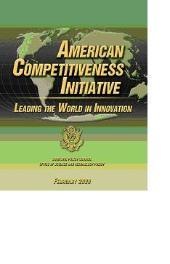 The American Competitiveness Initiative commits
$5.9 billion in FY 2007 to increase investments in research and development,
strengthen education, and encourage entrepreneurship. Over 10 years, the Initiative
commits $50 billion to increase funding for research and $86 billion for research
and development tax incentives. Federal investment in research and development has proved critical to keeping America’s economy
strong by generating knowledge and tools upon which new technologies are
developed.
The American Competitiveness Initiative commits
$5.9 billion in FY 2007 to increase investments in research and development,
strengthen education, and encourage entrepreneurship. Over 10 years, the Initiative
commits $50 billion to increase funding for research and $86 billion for research
and development tax incentives. Federal investment in research and development has proved critical to keeping America’s economy
strong by generating knowledge and tools upon which new technologies are
developed.
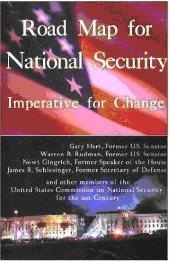 This report was co-chaired by Gary Hart and Warren
Rudman. It was produced well before
9/11.
This report was co-chaired by Gary Hart and Warren
Rudman. It was produced well before
9/11.
The report included 50 recommendations, 6 of which refer to
the need to increase science education directly.
5 of these 6 recommendations require Congressional action
for their successful implementation.
These recommendations were never implemented, but are still very much
needed for National Security.
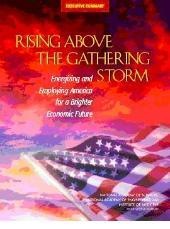 Rising Above The Gathering
Storm: Energizing and Employing America
for a Brighter Economic Future
Committee on Prospering in the
Global Economy of the 21st Century: An
Agenda for American Science and Technology, National Academy of Sciences,
National Academy of Engineering, Institute of Medicine.
ISBN: 0-309-65463-7, 504
pages, 6 x 9, (2005)
Rising Above The Gathering
Storm: Energizing and Employing America
for a Brighter Economic Future
Committee on Prospering in the
Global Economy of the 21st Century: An
Agenda for American Science and Technology, National Academy of Sciences,
National Academy of Engineering, Institute of Medicine.
ISBN: 0-309-65463-7, 504
pages, 6 x 9, (2005)
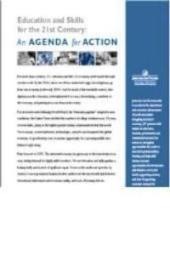 The
industrial economy has given way to the knowledge economy, fueling
demand for highly skilled workers. Yet our education and skills pipeline is leaking
badly and in need of significant repair. Stories in the media and speeches by America’s
most prominent business leaders underscore the inextricable link between educational
achievement and economic vitality and warn of looming threats.
This
report is from 2006.
The
industrial economy has given way to the knowledge economy, fueling
demand for highly skilled workers. Yet our education and skills pipeline is leaking
badly and in need of significant repair. Stories in the media and speeches by America’s
most prominent business leaders underscore the inextricable link between educational
achievement and economic vitality and warn of looming threats.
This
report is from 2006.
● These are just four of the many reports that have been developed that
refer to the need for more science instruction and focus at all levels of education in the United States.
● According to the Trends in International Mathematics and Science Study
(TIMSS) in 2007, the United
States ranks in the middle range compared to other industrialized
countries around the world in science and math test scores.
●Students in Ohio,
Pennsylvania and West Virginia rank in the lower middle range
of standardized test scores compared to students in other
states.
●Therefore the students in Ohio,
Pennsylvania and West Virginia’s preparedness for success in
a global market is mediocre at best.
●Areas with access to
a standards-based science center have shown annual increases in standardized
test scores.
●The
East Wheeling community already looks at Clay School
as being one of the corner stones of the community.
●The City of Wheeling is in need of
businesses that will create jobs.
●The Ohio Valley
region is in need of an educated workforce to attract new businesses to the
area.
●The development of the Science and Community Center will further the
revitalization of the East Wheeling Community.
●The development of the science and community
center will support the efforts of President Obama’s educational goals.

From the day I took office, I've been told that addressing our larger challenges is too ambitious; such effort would be toocontentious. I've been told that our political system is too gridlocked andthat we should just put things on hold for a while. For those who make these claims, I have one simplequestion: How long should we wait? How long should America put its future on hold? Yousee, Washingtonhas been telling us to wait for decades, even as the problems have grown worse.Meanwhile, China's notwaiting to revamp its economy; Germany'snot waiting; India'snot waiting.
These nations, they're not standing still. These nations aren't playing for second place. They're putting more emphasis on math and science. They're rebuilding their infrastructure. They're making serious investments in clean energy because they want those jobs.
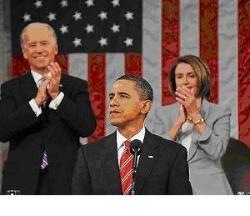 Well, I do not accept second place for the United States of America. We need to invest in the skills and educationof our people. Now, this year -- this year, we've broken through the stalematebetween left and right by launching a national competition to improve ourschools. And the idea here is simple:Instead of rewarding failure, we only reward success. Instead of funding thestatus quo, we only invest in reform, reform that raises student achievement,inspires students to excel in math and science, and turns around failingschools that steal the future of too many young Americans, from ruralcommunities to the inner city. In the21st century, the best anti-poverty program around is a world-class education. And in this country, the success of our children cannot depend more onwhere they live than on their potential. When we renew the Elementary andSecondary Education Act, we will work with Congress to expand these reforms toall 50 states.
Well, I do not accept second place for the United States of America. We need to invest in the skills and educationof our people. Now, this year -- this year, we've broken through the stalematebetween left and right by launching a national competition to improve ourschools. And the idea here is simple:Instead of rewarding failure, we only reward success. Instead of funding thestatus quo, we only invest in reform, reform that raises student achievement,inspires students to excel in math and science, and turns around failingschools that steal the future of too many young Americans, from ruralcommunities to the inner city. In the21st century, the best anti-poverty program around is a world-class education. And in this country, the success of our children cannot depend more onwhere they live than on their potential. When we renew the Elementary andSecondary Education Act, we will work with Congress to expand these reforms toall 50 states.
Still, in this economy, a high school diploma nolonger guarantees a good job. That's why I urge the Senate to follow the Houseand pass a bill that will revitalize our community colleges, which are a careerpathway to the children of so many working families.
To make college more affordable, this bill willfinally end the unwarranted taxpayer subsidies that go to banks for studentloans. Instead, let's take that money and give families a $10,000 tax creditfor four years of college and increase Pell Grants.
And let's tell another 1 million students that,when they graduate, they will be required to pay only 10 percent of theirincome on student loans, and all of their debt will be forgiven after 20 years,and forgiven after 10 years if they choose a career in public service, becausein the United States of America, no one should go broke because they chose togo to college.